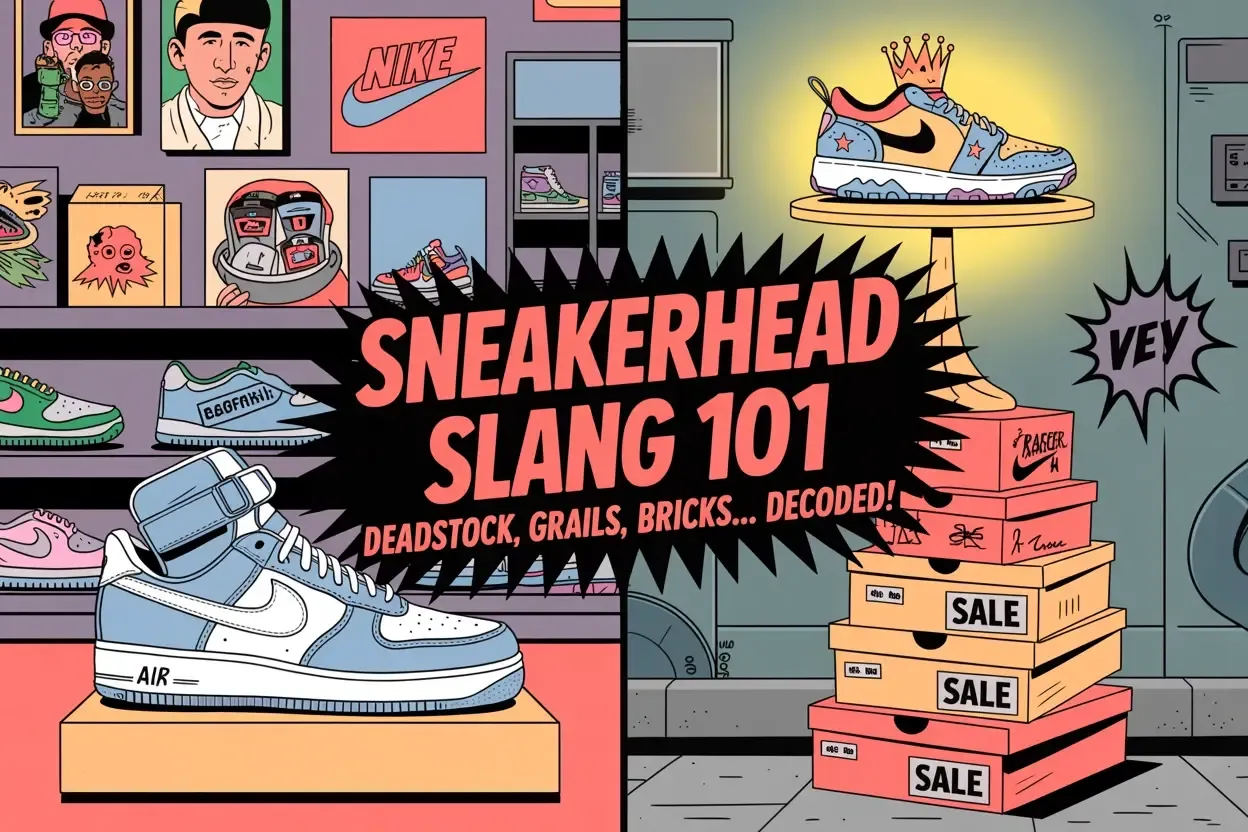
Table of Contents
Step into any online forum, Discord server, or even a physical sneaker event, and you'll quickly realize that sneaker enthusiasts aren't just speaking English – they're speaking "sneaker."It's a vibrant, ever-evolving lexicon, a secret handshake for those in the know. Honestly, trying to navigate conversations without understanding the lingo can feel like you're trying to run a marathon in flip-flops.
But why all the specialized terms? Well, when something becomes more than just an object – when it becomes a cultural artifact laden with social, economic, and personal meaning – a specialized language just naturally pops up to talk about all that complexity, you know? Sneakers have totally made that leap, transitioning from just something you wear on your feet to powerful symbols of identity, status, and even investment. This report I've been looking at digs deep into this, showing how sneaker slang is a dynamic social tool, helping people connect, show who they are, and even reflect the drama and excitement within the community. It's a linguistic fingerprint, really, helping this global subculture build and protect its boundaries.
So, whether you're new to the game or just want to brush up on your terms, get ready. We're about to break down the essential vocabulary that makes the sneaker world go 'round.
Your Sneakerhead Dictionary: Essential Terms You Need to Know
Alright, let's get down to the nitty-gritty. What do these words actually mean? We'll cover some of the most common and crucial terms you'll hear.
The Holy Trinity (or Maybe Not?): Deadstock, Grails, and Bricks

These three terms often come up in conversations about a shoe's condition, desirability, and value. But their meanings can sometimes spark a little debate.
- Deadstock (DS): You hear this all the time. Originally, in regular retail speak, "dead stock" (often two words back then) meant inventory that just sat there, unsold and gathering dust. But in the sneaker world? Totally different meaning. Deadstock (DS) means a shoe is brand new, never worn, completely unused, and usually comes with all its original packaging, tags, and anything else that came in the box. It's basically in factory condition. This term is super important because a shoe's condition directly impacts its resale value, especially if there's money on the line, or if the shoe is destined for a collection, perhaps even one day becoming museum-worthy kicks. That's why you see even more specific terms pop up, like VNDS (Very Near Deadstock) or PADS (Pass As Deadstock), for shoes worn maybe once or twice but still in almost perfect shape. It shows just how much collectors focus on keeping kicks pristine.
- Grails: Ah, the grail. This one is borrowed straight from the legend of the Holy Grail – that epic, difficult quest for something of ultimate value. In sneaker culture, your Grail(s) are those highly desired pairs you've been searching for, maybe for ages. They're often rare, could be super expensive, or just hold deep personal meaning for you – maybe a shoe you couldn't get as a kid, or one tied to a special memory, like a coveted piece from an anime-inspired sneaker collaboration. A Holy Grail often implies an even more elusive, maybe nearly impossible-to-find, ultimate target. Here's where the debate comes in: some feel the term "grail" gets thrown around too casually now for any shoe that's just currently hyped, diluting its original meaning of a truly rare and personally significant chase.
- Bricks: This term has a fascinating, slightly contentious history. It started pretty much as insider slang within the sneaker reselling community. Bricks are sneakers that are hard to sell, don't have much (or any) resale value, and basically just "sit" there, tying up a reseller's money like, well, a heavy stack of bricks. It's a term rooted in profitability, or lack thereof. But now, you hear non-resellers using it too, often to describe shoes they personally find ugly or that just aren't popular with the wider community. This broader usage causes some friction. Some folks argue that calling a shoe a "brick" automatically means you're prioritizing its resale value over its design or whether you actually like it. It really highlights that ongoing tension between collecting for passion versus collecting for profit.
The Thrill of the Chase & the Agony of Defeat:
Buying limited sneakers, especially online, can be a wild ride. These terms perfectly capture the highs and lows.
- Cop / Drop: Simple, yet fundamental. To cop means to buy or acquire a pair of sneakers. It likely comes from general street slang that means "to get" or "to obtain." A drop is the release of new sneakers or merchandise. But here's a fun twist: in the context of a question like "Cop or drop?", "drop" means deciding not to buy the shoe.
- L / W: These are probably the most emotionally charged terms, especially around release times. L stands for Loss – meaning you failed to get the sneakers you wanted, maybe in a raffle or an online release. It's the ubiquitous expression of disappointment. Conversely, W stands for Win – you successfully copped the coveted pair! These terms were borrowed from sports and gaming to describe the outcome of competitive attempts. The sheer frequency of taking "Ls" in the current sneaker market, thanks to massive demand and bots (more on those in a bit!), has even pushed the term "L" into broader online slang to mean a general failure or setback.
Status and Authenticity:
Sneaker culture definitely has its own ideas about what's "hot" and what's real.
- Heat: This is straightforward slang for something excellent or impressive. In the sneaker world, Heat refers to rare, highly sought-after, or just exceptionally good-looking sneakers, sometimes catapulted to fame by appearances in sneakers in cinema. It's what everyone wants to see when you show off your collection.
- OG (Original/Original Release): This term carries a lot of respect. OG means the first version of a specific sneaker model or colorway that was released to the public. It's important for distinguishing those initial drops from later re-releases, known as Retros. The term itself is borrowed from hip-hop, where "Original Gangster" signifies authenticity and pioneering status. "OG" sneakers are prized for their history, original design details, and connection to specific cultural moments, much like certain OG sneakers that defined rave culture. While Retros are great for letting newer fans get classic looks, OGs often have that extra layer of authenticity and value. It's worth noting "OG" can have slightly different nuances depending on the context, sometimes referring just to the original colorway or even a pair with all its original accessories.
- Fufu / Fugazi: These terms are used to describe fake or counterfeit sneakers. The origin of Fugazi is debated, possibly coming from Italian or military slang meaning fake or messed up. Fufu is often seen as a shortened or more playful version. The very existence of these terms shows how much the community cares about authenticity.
- Legit Check (LC): Because fakes are a real issue, the community developed the practice of performing a Legit Check, or LC. This is where members scrutinize photos of a sneaker, pointing out details like stitching, materials, or tags to help verify if it's genuine. It's a crucial form of self-policing to protect buyers.
Community Labels & Descriptions:
- Hypebeast: This term emerged from early sneaker forums and is a combination of "hype" (intense excitement) and "beast" (someone with consuming enthusiasm). A Hypebeast is generally used to describe someone who buys sneakers primarily based on current trends and hype, often for status, rather than genuine personal appreciation for the shoe itself, a phenomenon also seen in the K-Pop sneaker scene where idol influence drives trends. It often carries a negative or critical tone, implying a lack of original taste.
- Beaters: These are the workhorse sneakers in your rotation. Beaters are shoes you wear regularly for everyday stuff, without worrying too much about keeping them spotless. They're meant to get "beaten up" through use, a stark contrast to the pristine "deadstock" pairs and a philosophy embraced by punk anti-sneakerheads. Using this term kind of sets up a contrast with those pristine, "deadstock" pairs that are carefully stored away.
- Colorway (CW): Pretty simple, this just refers to the specific combination of colors used on a sneaker.
- TTS (True To Size): Super important, especially when buying online! TTS means the sneaker fits according to standard sizing. Since sizing can vary between brands and even models, knowing if a shoe runs TTS, runs small, or runs big is essential information shared within the community to help avoid returns.
There are tons more terms out there – from acronyms like WDYWT (What Did You Wear Today?) to names for specific Nike lines like SB (Skateboarding). The language is always growing!
How the Language Spreads: From Forums to TikTok
So, how does a term go from being used by a few people to becoming part of the common sneaker lexicon? It's a dynamic process with different platforms playing key roles.
- The Old Guard: Back in the day, before social media as we know it, online forums like NikeTalk (started in 1999) and Sole Collector were the absolute hubs for sneakerheads. These were text-based communities where collectors, traders, and enthusiasts gathered globally. They were crucial "incubators" for early sneaker slang, especially terms related to buying, selling (like BIN - Buy It Now), and condition (like DS). The constant interaction in these focused spaces helped solidify a common vocabulary.
- The Modern Era: As the internet evolved, new platforms took the reins and adapted the language. Reddit, particularly subreddits like r/Sneakers, became massive forums for the modern community. You'll find a lot of the old-school slang here, mixed in with general Reddit lingo. The structure allows for broad discussions, showing off collections (LPUs - Latest Pick Ups), and sharing those painful "L" stories. Then there's Discord. This platform, with its real-time chat, is huge for fostering rapid communication. It's a major spot for various sneaker groups, especially the more private "cook groups."
- The Influencer Effect: You can't talk about how slang spreads today without mentioning influencers. YouTubers doing reviews and unboxings, and TikTok creators making quick, engaging videos, are powerful forces in popularizing sneaker speak to huge audiences. They might explain terms, use them constantly, or even come up with their own catchphrases that catch on. Think about how visual terms, or simple nicknames like "Panda Dunks" (for the black and white Nike Dunk Low, because, well, they look like a panda) , can spread like wildfire on platforms like TikTok where visuals are key.
Inside the Cook Group: Bots, Reselling, and Specialized Jargon

Now, let's talk about a part of the sneaker world that has a huge influence on the language, and can be a real point of contention: the reseller community and their "cook groups."
Reselling sneakers – buying them specifically to sell for a profit – has become a massive market. This is where the motivations of profit-driven resellers often clash with those of passion-driven enthusiasts. And this dynamic has created its own specialized vocabulary.
- Bots: These are automated software programs designed to buy limited sneakers online at lightning speed, often in quantities a human just couldn't manage. They're a major tool for resellers looking to secure stock for "flipping" (buying to resell for profit). For regular enthusiasts trying to buy a single pair manually, bots are a huge source of frustration and a big reason for those frequent "Ls." Discussions about bots often highlight feelings of unfairness in the release system.
- Cook Groups: These are typically private, often paid, online communities (usually on Discord) that act as nerve centers for resellers. Members share crucial, often time-sensitive information like 'early links' to product pages before they go public, data from 'monitors' that track restocks, and even access to 'auto checkout' (ACO) services that use bots to complete purchases instantly.
The language within these cook groups can be highly technical and coded. Terms like 'cook' or 'cooking' mean successfully acquiring a large number of limited items, often implying the skillful use of bots and strategy. They might discuss securing 'slots' (guaranteed purchases) or aiming for a profitable 'flip'. While some of this jargon stays within these private circles, other terms, like the concept of 'bots' themselves or the term 'bricks', definitely filter out into the broader sneaker conversation because the actions of resellers directly impact everyone trying to buy shoes. The idea of getting shoes via 'backdoor' (through unofficial or insider channels, bypassing public releases) is another reseller concept that causes resentment among enthusiasts who feel locked out.
This specialized language born from the resale market vividly illustrates the economic forces at play in sneaker culture and the linguistic tensions between passion and profit.
More Than Just Talking Shoes: The Cultural Impact
Sneaker slang isn't just about describing shoes or transactions; it's deeply woven into the fabric of the community and performs important cultural work.
- Identity: Knowing and using the slang is a key way to show you're part of the club. Fluency in this language signals cultural competence and immersion, granting you "insider" status. It's like a form of cultural capital – the more you know and use the terms correctly, the more respect you might gain within the community. Think about it: correctly using "OG" and explaining why that specific year or detail matters shows you know your history. The focus on authenticity, seen in terms for fakes like "fufu" and the practice of "Legit Checks," is also about protecting the value of genuine products and signaling genuine participation in the culture. Even something like using the term "beaters" can reflect a part of your identity – maybe you prioritize wearing and enjoying your shoes over keeping them spotless.
- Values: The prevalence of certain terms directly reflects what the community values. The abundance of terms related to rarity and exclusivity – "grail," "F&F" (Friends & Family, ultra-exclusive pairs given to insiders), "PE" (Player Exclusive), "QS" (Quickstrike), "HS" (Hyperstrike, even more limited) – shows how much importance is placed on owning items that are hard to get. Terms like "OG" and "Retro" highlight an appreciation for the history and heritage of sneaker design. And words like "heat" and "hype" reflect the community's engagement with the social status and excitement surrounding popular releases.
- Tension: We've touched on this, but it's worth emphasizing: slang is a battleground for the tensions within the culture. The language used around "bricks," "bots," and "flipping" vividly captures the conflict between those who see sneakers primarily as items of passion and those who see them as assets to profit from. The debates over the meaning of "bricks," for instance, aren't just about a word; they're about differing value systems.
Beyond Borders and Platforms: Sneaker Speak Variations
While a lot of the core sneaker slang is rooted in American English (makes sense, given the history of sneaker and hip-hop culture), it's a global phenomenon, and the language reflects that.
You'll find regional variations. For example, while most people say "sneakers," in the UK they often say "trainers," or the slang term "creps." In New York City, Nike Air Force 1s are often called "Uptowns." Australians might call them "runners." Different parts of Latin America use terms like "zapatillas" or "tenis." Even within the US, there can be subtle regional differences.
And as we discussed, the platform you're on can feel like a different platform dialect. The old forums were all about acronyms for efficiency in text. Reddit blends that with its own lingo and uses visuals heavily. Discord is fast-paced and real-time, with specialized, sometimes ephemeral, jargon in private groups. And TikTok, being so visual and short-form, favors terms that are easily demonstrated or tied to quick trends. The way slang spreads and the types of slang that catch on are definitely shaped by these digital environments.
Conclusion: The Living Language of Laces
Stepping into the world of sneaker collecting means learning a new language. Sneakerhead slang is a rich, dynamic, and vital part of the subculture. It's not just a random collection of words; it's a living system that helps people connect, express who they are, argue about what matters, and navigate a complex market driven by passion, hype, and profit.
From understanding what "deadstock" really means to knowing why calling a shoe "bricks" can spark debate, mastering this lingo is key to truly participating in the community. It reflects the culture's values – the reverence for OGs, the quest for grails, the frustration with bots, and the constant negotiation between authenticity and hype.
As sneaker culture continues to grow and evolve globally, so too will its language. The slang used by sneakerheads is a testament to their creativity and the unique identity they've built, one term, one release, and one conversation at a time. It’s the glue that holds the community together, one linguistic lace at a time.


